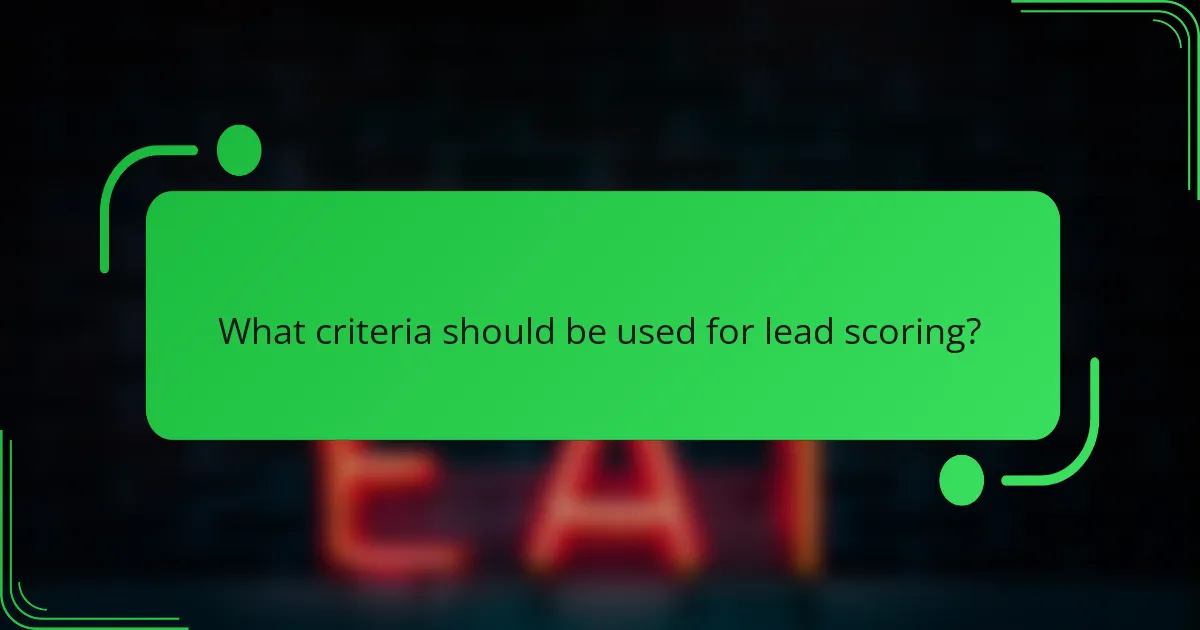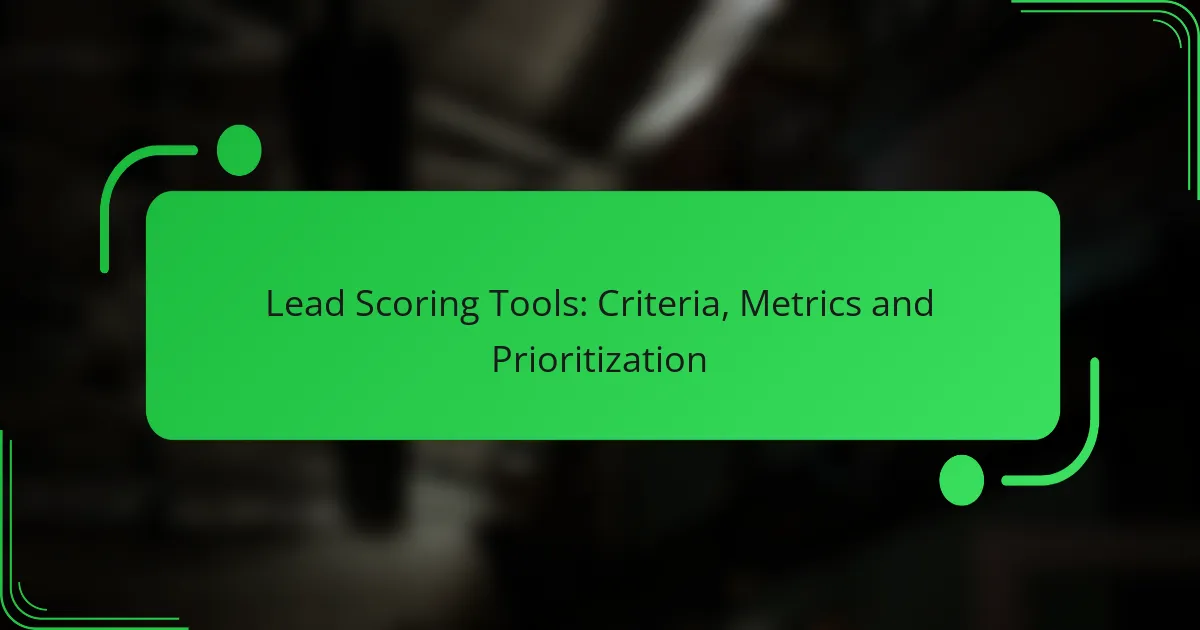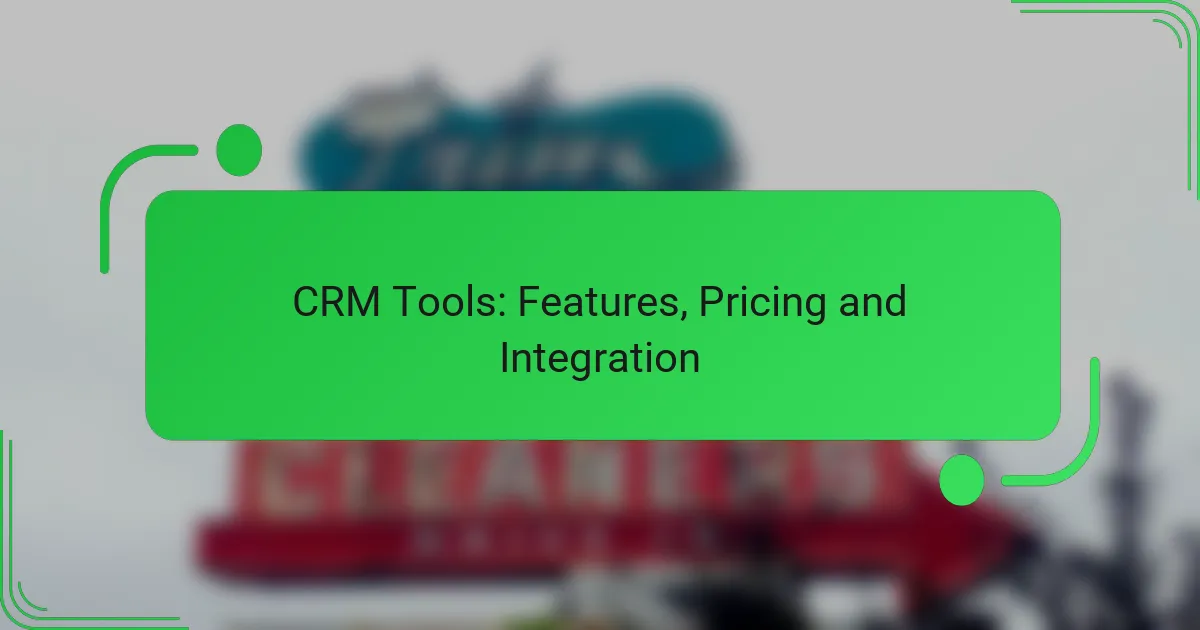Lead scoring tools are essential for businesses seeking to optimize their sales processes by analyzing and prioritizing leads based on specific criteria and metrics. By focusing on the most promising prospects, these tools enhance conversion rates and overall sales efficiency. Implementing an effective lead scoring system involves establishing clear evaluation criteria and integrating it with existing CRM tools to streamline the sales process.

What are the best lead scoring tools for businesses?
The best lead scoring tools for businesses include platforms that effectively analyze and prioritize leads based on various criteria and metrics. These tools help sales teams focus their efforts on the most promising prospects, ultimately improving conversion rates and sales efficiency.
HubSpot
HubSpot offers a user-friendly lead scoring system that integrates seamlessly with its CRM. It allows businesses to assign scores based on demographic and behavioral data, such as website visits and email engagement.
One key feature is the ability to customize scoring criteria to align with specific business goals. For example, leads that download a whitepaper may receive a higher score, indicating a stronger interest in your offerings.
Salesforce
Salesforce provides a robust lead scoring tool that leverages AI to analyze lead data and predict conversion likelihood. Its Einstein Lead Scoring feature assesses historical data to identify patterns and assign scores accordingly.
Businesses can benefit from Salesforce’s extensive customization options, allowing them to tailor scoring models based on unique sales processes. Regularly reviewing and adjusting these criteria can enhance scoring accuracy over time.
Marketo
Marketo’s lead scoring capabilities focus on both explicit and implicit data, helping businesses gauge lead quality effectively. Users can set up rules based on actions such as email opens, clicks, and social media interactions.
Marketo also allows for the creation of scoring thresholds, enabling teams to prioritize leads that meet specific criteria. This can streamline follow-up efforts and improve overall lead management.
Zoho CRM
Zoho CRM features a straightforward lead scoring system that evaluates leads based on various attributes, including source, engagement level, and demographic information. Users can assign scores manually or automate the process using predefined rules.
One advantage of Zoho is its affordability, making it accessible for small to medium-sized businesses. Regularly updating scoring criteria based on market changes can enhance lead prioritization.
ActiveCampaign
ActiveCampaign offers a comprehensive lead scoring feature that integrates with its marketing automation tools. It allows businesses to track user behavior and assign scores based on engagement metrics like email interactions and website visits.
The platform’s automation capabilities enable users to trigger specific actions when leads reach certain score thresholds, enhancing follow-up strategies. Regular analysis of scoring effectiveness can help refine these processes for better results.

How to implement lead scoring effectively?
To implement lead scoring effectively, establish clear criteria for evaluating leads and integrate this system with your existing customer relationship management (CRM) tools. This process enhances sales efficiency by prioritizing leads based on their likelihood to convert.
Define scoring criteria
Defining scoring criteria involves identifying the key attributes that indicate a lead’s potential value. Common factors include demographic information, engagement levels, and behavioral data. For example, a lead from a target industry who has interacted with your content multiple times may score higher than a less engaged lead.
Consider using a point system where each criterion is assigned a specific weight based on its importance. This allows for a more nuanced evaluation of leads. Regularly review and adjust these criteria to reflect changes in market conditions or business goals.
Integrate with CRM
Integrating your lead scoring system with your CRM is crucial for seamless tracking and management. This integration allows sales teams to access real-time scoring data, ensuring they focus on the most promising leads. Most modern CRMs offer built-in lead scoring features or can be customized to include your specific criteria.
Ensure that your CRM captures all relevant lead interactions, such as email opens, website visits, and social media engagement. This data feeds into the scoring model, providing a comprehensive view of each lead’s activity and interest level.
Train sales teams
Training sales teams on the lead scoring system is essential for maximizing its effectiveness. Provide clear guidelines on how to interpret scores and prioritize leads accordingly. This training should include practical examples and role-playing scenarios to reinforce learning.
Encourage ongoing feedback from sales teams to refine the scoring process. Regular check-ins can help identify any challenges they face and allow for adjustments to the criteria or training methods as needed. This collaborative approach fosters a culture of continuous improvement and alignment between marketing and sales efforts.

What criteria should be used for lead scoring?
Effective lead scoring relies on a combination of criteria that assess the potential value of leads. Key factors include demographic information, behavioral data, and engagement levels, each contributing to a comprehensive understanding of a lead’s likelihood to convert.
Demographic information
Demographic information encompasses details such as age, gender, location, job title, and industry. These factors help identify the target audience and segment leads effectively. For instance, leads from specific industries or job roles may be prioritized based on their alignment with your product or service offerings.
When scoring leads, consider using a point system where certain demographics earn higher scores. For example, a lead from a high-value industry might receive more points than one from a less relevant sector. This approach helps in focusing efforts on the most promising prospects.
Behavioral data
Behavioral data tracks how leads interact with your brand, including website visits, content downloads, and email engagement. This information provides insights into a lead’s interests and intent. For example, a lead who frequently visits product pages or downloads whitepapers may indicate a stronger interest in your offerings.
To effectively utilize behavioral data, assign scores based on specific actions. Engaging with a demo video could earn more points than simply opening an email. This scoring method helps prioritize leads who show genuine interest in your products or services.
Engagement level
Engagement level measures how actively a lead interacts with your marketing efforts. This includes responses to emails, participation in webinars, and social media interactions. High engagement levels often correlate with a greater likelihood of conversion.
To assess engagement, consider tracking metrics such as email open rates and click-through rates. Leads who consistently engage with your content should be prioritized. Avoid overlooking leads with lower engagement; they may still convert with the right nurturing strategies.

What metrics are essential for lead scoring?
Essential metrics for lead scoring include lead conversion rate, engagement score, and time to conversion. These metrics help businesses prioritize leads based on their likelihood to convert into customers, allowing for more effective sales strategies.
Lead conversion rate
The lead conversion rate measures the percentage of leads that successfully become paying customers. This metric is crucial as it directly reflects the effectiveness of your sales process and marketing efforts. A typical conversion rate can range from low single digits to over 20%, depending on the industry and the quality of leads.
To improve your lead conversion rate, focus on nurturing high-quality leads through targeted content and personalized communication. Regularly analyze conversion data to identify trends and adjust your strategies accordingly.
Engagement score
Engagement score quantifies how actively a lead interacts with your brand, including website visits, email opens, and social media interactions. Higher engagement scores indicate a stronger interest in your products or services, making these leads more likely to convert. Tools like HubSpot or Salesforce can help track and calculate these scores effectively.
To enhance engagement scores, create compelling content and utilize marketing automation to maintain consistent communication. Monitor engagement trends to identify which channels yield the best results and focus your efforts there.
Time to conversion
Time to conversion measures the duration it takes for a lead to move from initial contact to becoming a customer. Understanding this metric helps businesses streamline their sales processes and identify bottlenecks. Typical timeframes can vary widely, from a few days to several months, depending on the product and sales cycle.
To reduce time to conversion, ensure that your sales team is equipped with the right tools and information to address leads promptly. Regularly review your sales pipeline to identify delays and implement strategies to expedite the conversion process.

How to prioritize leads based on scoring?
Prioritizing leads based on scoring involves evaluating and ranking potential customers according to their likelihood to convert. This process helps sales teams focus their efforts on the most promising leads, improving efficiency and conversion rates.
Focus on high-scoring leads
High-scoring leads should be the primary focus of your sales efforts. These leads typically exhibit strong engagement signals, such as frequent website visits, content downloads, or interactions with your brand on social media. By concentrating on these leads, sales teams can maximize their chances of closing deals.
To effectively prioritize, establish a scoring system that assigns points based on specific criteria, such as demographic fit, behavioral actions, and engagement levels. For example, a lead that downloads a whitepaper may score higher than one that merely visits your homepage.
Segment leads for targeted outreach
Segmenting leads based on their scores allows for more personalized and effective outreach strategies. By grouping leads into categories—such as high, medium, and low scores—sales teams can tailor their messaging and offers to match the interests and needs of each segment.
For instance, high-scoring leads may benefit from direct calls or personalized emails, while medium-scoring leads could receive targeted content marketing. This approach not only enhances engagement but also optimizes resource allocation, ensuring that your team invests time where it is most likely to yield results.



